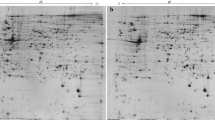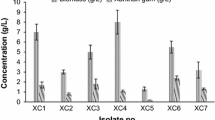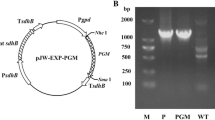Abstract
Cell growth and product formation are two critical processes in polysaccharide welan biosynthesis, but the conflict between them is often encountered. In this study, a temperature-dependent strategy was designed for two-stage welan production through overexpressing heat shock proteins in Sphingomonas sp. The first stage was cell growth phase with higher TCA cycle activity at 42 °C; the second stage was welan formation phase with higher precursor synthesis pathway activity at 37 °C. The highest welan concentration 37.5 g/L was achieved after two-stage process. Ultimately, this strategy accumulated welan yield of 79.2 g/100 g glucose and productivity of 0.62 g/L/h at 60 h, which were the best reported results so far. The duration of fermentation was shortened. Besides, rheological behavior of welan gum solutions remained stable at wide range of temperature, pH, and NaCl. These results indicated that this approach efficiently improved welan synthesis.





Similar content being viewed by others
References
Schmid J, Sperl N, Sieber V (2014) A comparison of genes involved in sphingan biosynthesis brought up to date. Appl Microbiol Biotechnol 98(18):7719–7733
Roca C, Alves VD, Freitas F, Reis MA (2015) Exopolysaccharides enriched in rare sugars: bacterial sources, production, and applications. Front Microbiol 6:288
Zhao F, Guo C, Cui Q, Hao Q, Xiu J, Han S, Zhang Y (2018) Exopolysaccharide production by an indigenous isolate Pseudomonas stutzeri XP1 and its application potential in enhanced oil recovery. Carbohydr Polym 199:375–381
Kaur V, Bera MB, Panesar PS, Kumar H, Kennedy JF (2014) Welan gum: microbial production, characterization, and applications. Int J Biol Macromol 65:454–461
Xu L, Xu G, Liu T, Chen Y, Gong H (2013) The comparison of rheological properties of aqueous welan gum and xanthan gum solutions. Carbohydr Polym 92(1):516–522
Zhu H, Sun SW, Li H, Chang AP, Liu YC, Qian J, Shen YL (2019) Significantly improved production of Welan gum by Sphingomonas sp. WG through a novel quorum-sensing-interfering dipeptide cyclo(L-Pro-L-Phe). Int J Biol Macromol 126:118–122
Alkhateeb RS, Vorhölter FJ, Steffens T, Rückert C, Ortseifen V, Hublik G, Niehaus K, Pühler A (2018) Comparative transcription profiling of two fermentation cultures of Xanthomonas campestris pv. campestris B100 sampled in the growth and in the stationary phase. Appl Microbiol Biotechnol 102(15):6613–6625
Li H, Jiao X, Sun Y, Sun S, Feng Z, Zhou W, Zhu H (2016) The preparation and characterization of a novel sphingan WL from marine Sphingomonas sp. WG Sci Rep 6:37899
Li H, Xu H, Li S, Feng XH, Ouyang PK (2012) Optimization of exopolysaccharide welan gum production by Alcaligenes sp. CGMCC2428 with Tween-40 using response surface methodology. Carbohydr Polym 87:1363–1368
Hsu CH, Martin Lo Y (2003) Characterization of xanthan gum biosynthesis in a centrifugal, packed-bed reactor using metabolic flux analysis. Process Biochem 38:1617–1625
Li H, Xu H, Xu H, Li S, Ouyang PK (2010) Biosynthetic pathway of sugar nucleotides essential for welan gum production in Alcaligenes sp. CGMCC2428. Appl Microbiol Biotechnol 86:295–303
Klamt S, Mahadevan R, Hädicke O (2018) When do two-stage processes outperform one-stage processes? Biotechnol J 13:1700539
Zhou P, Xie W, Yao Z, Zhu Y, Ye L, Yu H (2018) Development of a temperature-responsive yeast cell factory using engineered Gal4 as a protein switch. Biotechnol Bioeng 115:1321–1330
Harder BJ, Bettenbrock K, Klamt S (2018) Temperature-dependent dynamic control of the TCA cycle increases volumetric productivity of itaconic acid production by Escherichia coli. Biotechnol Bioeng 115:156–164
Priya A, Dureja P, Talukdar P, Rathi R, Lal B, Sarma PM (2016) Microbial production of 2,3-butanediol through a two-stage pH and agitation strategy in 150 l bioreactor. Biochem Eng J 105:159–167
Venayak N, Anesiadis N, Cluett WR, Mahadevan R (2015) Engineering metabolism through dynamic control. Curr Opin Biotechnol 34:142–152
Chen CY, Yang YT (2018) Combining engineering strategies and fermentation technology to enhance docosahexaenoic acid (DHA) production from an indigenous Thraustochytrium sp. BM2 strain. Biochem Eng J 133:179–185
Chakshusmathi G, Mondal K, Lakshmi GS, Singh G, Roy A, Ch RB, Madhusudhanan S, Varadarajan R (2004) Design of temperature-sensitive mutants solely from amino acid sequence. Proc Natl Acad Sci USA 101(21):7925–7930
Kitano H (2004) Biological robustness. Nat Rev Genet 5(11):826–837
Kambourova M, Mandeva R, Dimova D, Poli A, Nicolaus B, Tommonaro G (2009) Production and characterization of a microbial glucan, synthesized by Geobacillus tepidamans V264 isolated from Bulgarian hot spring. Carbohydr Polym 77:338–343
Radchenkova N, Vassilev S, Panchev I, Anzelmo G, Tomova I, Nicolaus B, Kuncheva M, Petrov K, Kambourova M (2013) Production and properties of two novel exopolysaccharides synthesized by a thermophilic bacterium Aeribacillus pallidus 418. Appl Biochem Biotechnol 171(1):31–43
Yasar Yildiz S, Anzelmo G, Ozer T, Radchenkova N, Genc S, Di Donato P, Nicolaus B, Toksoy Oner E, Kambourova M (2014) Brevibacillus themoruber: a promising microbial cell factory for exopolysaccharide production. J Appl Microbiol 116(2):314–324
Rudolph B, Gebendorfer KM, Buchner J, Winter J (2010) Evolution of Escherichia coli for growth at high temperatures. J Biol Chem 285(25):19029–19034
Lin Z, Zhang Y, Wang J (2013) Engineering of transcriptional regulators enhances microbial stress tolerance. Biotechnol Adv 31(6):986–991
Luan G, Dong H, Zhang T, Lin Z, Zhang Y, Li Y, Cai Z (2014) Engineering cellular robustness of microbes by introducing the GroESL chaperonins from extremophilic bacteria. J Biotechnol 178:38–40
Feder ME, Hofmann GE (1999) Heat-shock proteins, molecular chaperones, and the stress response: evolutionary and ecological physiology. Annu Rev Physiol 61:243–282
Tomas CA, Welker NE, Papoutsakis ET (2003) Overexpression of groESL in Clostridium acetobutylicum results in increased solvent production and tolerance, prolonged metabolism, and changes in the cell's transcriptional program. Appl Environ Microbiol 69(8):4951–4965
Liu Y, Zhang G, Sun H, Sun X, Jiang N, Rasool A, Lin Z, Li C (2014) Enhanced pathway efficiency of Saccharomyces cerevisiae by introducing thermo-tolerant devices. Bioresour Technol 170:38–44
Kovach ME, Elzer PH, Hill DS, Robertson GT, Farris MA, Roop RMII, Peterson KM (1995) Four new derivatives of the broad-host-range cloning vector pBBR1MCS, carrying different antibiotic-resistance cassettes. Gene 166:175–176
Zhu P, Dong SH, Li S, Xu XY, Xu H (2014) Improvement of welan gum biosynthesis and transcriptional analysis of the genes responding to enhanced oxygen transfer by oxygen vectors in Sphingomonas sp. Biochem Eng J 90:264–271
Livak KJ, Schmittgen TD (2001) Analysis of relative gene expression data using real-time quantitative PCR and the 2 −ΔΔCt method. Methods 25:402–408
Lara AR, Leal L, Flores N, Gosset G, Bolivar F, Ramirez OT (2006) Transcriptional and metabolic response of recombinant Escherichia coli to spatial dissolved oxygen tension gradients simulated in a scale-down system. Biotechnol Bioeng 93:372–385
Kirby DM, Thorburn DR, Turnbull DM, Taylor RW (2007) Biochemical assays of respiratory chain complex activity. Methods Cell Biol 80:93–119
Mhamdi A, Mauve C, Gouia H, Saindrenan P, Hodges M, Noctor G (2010) Cytosolic NADP-dependent isocitrate dehydrogenase contributes to redox homeostasis and the regulation of pathogen responses in Arabidopsis leaves. Plant Cell Environ 33:1112–1123
Robinson JB, Inman L, Sumegi B, Srere PA (1987) Further characterization of the krebs tricarboxylic acid cycle metabolon. J Biol Chem 262:1786–1790
Zhang S, Bryant DA (2011) The tricarboxylic acid cycle in cyanobacteria. Science 334:1551–1553
Arrecubieta C, Garcia E, Lopez R (1996) Demonstration of UDP-glucose dehydrogenase activity in cell extracts of Escherichia coli expressing the pneumococcal cap3A gene required for the synthesis of type 3 capsular polysaccharide. J Bacteriol 178:2971–2974
Videira PA, Cortes LL, Fialho AM, Sá-Correia I (2000) Identification of the pgmG gene, encoding a bifunctional protein with phosphoglucomutase and phosphomannomutase activities, in the gellan gum-producing strain Sphingomonas paucimobilis ATCC 31461. Appl Environ Microbiol 66:2252–2258
Sá-Correia I, Fialho AM, Videira P, Moreira LM, Marques AR, Albano H (2002) Gellan gum biosynthesis in Sphingomonas paucimobilis ATCC 31461: genes, enzymes and exopolysaccharide production engineering. J Ind Microbiol Biotechnol 29:170–176
Silva E, Marques AR, Fialho AM, Granja AT, Sá-Correia I (2005) Proteins encoded by Sphingomonas elodea ATCC 31461 rmlA and ugpG genes, involved in gellan gum biosynthesis, exhibit both dTDP- and UDP-glucose pyrophosphorylase activities. Appl Environ Microbiol 71(8):4703–4712
Bradford MM (1976) A rapid and sensitive method for the quantitation of microgram quantities of protein utilizing the principle of protein-dye binding. Anal Biochem 72:248–254
Gengenbacher M, Rao SP, Pethe K, Dick T (2010) Nutrient-starved, non-replicating Mycobacterium tuberculosis requires respiration, ATP synthase and isocitrate lyase for maintenance of ATP homeostasis and viability. Microbiology 156:81–87
Zhu P, Chen XY, Li S, Xu H, Dong SH, Xu ZQ, Zhang Y (2014) Screening and characterization of Sphingomonas sp. mutant for welan gum biosynthesis at an elevated temperature. Bioprocess Biosyst Eng 37:1849–1858
Walter S, Buchner J (2002) Molecular chaperones-cellular machines for protein folding. Angew Chem Int Ed Engl 41:1098–1113
Soma Y, Tsuruno K, Wada M, Yokota A, Hanai T (2014) Metabolic flux redirection from a central metabolic pathway toward a synthetic pathway using a metabolic toggle switch. Metab Eng 23:175–184
Hamcerencu M, Desbrieres J, Popa M, Riess G (2009) Stimuli-sensitive xanthan derivatives/N-isopropylacrylamide hydrogels: influence of cross-linking agent on interpenetrating polymer network properties. Biomacromol 10(7):1911–1922
Gustafsson L (1991) Microbiological calorimetry. Thermochim Acta 193:145–171
Woo JM, Yang KM, Kim SU, Blank LM, Park JB (2014) High temperature stimulates acetic acid accumulation and enhances the growth inhibition and ethanol production by Saccharomyces cerevisiae under fermenting conditions. Appl Microbiol Biotechnol 98(13):6085–6094
Wang J, Wang W, Wang H, Yuan F, Xu Z, Yang K, Li Z, Chen Y, Fan K (2019) Improvement of stress tolerance and riboflavin production of Bacillus subtilis by introduction of heat shock proteins from thermophilic bacillus strains. Appl Microbiol Biotechnol 103(11):4455–4465
Hendriks ATWM, van Lier JB, de Kreuk MK (2018) Growth media in anaerobic fermentative processes: The underestimated potential of thermophilic fermentation and anaerobic digestion. Biotechnol Adv 36(1):1–13
Wu SJ, Chen HQ, Jin ZY, Tong QY (2010) Effect of two-stage temperature on pullulan production by Aureobasidium pullulans. World J Microb Biot 26:737–741
Zhu GL, Sheng L, Tong QY (2013) A new strategy to enhance gellan production by two-stage culture in Sphingomonas paucimobilis. Carbohydr Polym 98:829–834
Ai HX, Liu M, Yu PR, Zhang SZ, Suo YK, Luo P, Li S, Wang JF (2015) Improved welan gum production by Alcaligenes sp. ATCC31555 from pretreated cane molasses. Carbohydr Polym 129:35–43
Liu XL, Lin LJ, Xu XY, Zhang H, Wu LT, Zhu P, Li S, Xu H (2018) Two-step economical welan gum production by Sphingomonas sp. HT-1 from sugar industrial by-products. Carbohydr Polym 181:412–418
Silva C, Torres MD, Chenlo F, Moreir R (2017) Rheology of aqueous mixtures of tragacanth and guar gums: effects of temperature and polymer ratio. Food Hydrocoll 69:293–300
Medina-Torres L, Brito-De La Fuente E, Torrestiana-Sanchez B, Katthain R (2000) Rheological properties of the mucilage gum (Opuntia ficus indica). Food Hydrocoll 14(5):417–424
Hoffmann F, Weber J, Rinas U (2002) Metabolic adaptation of Escherichia coli during temperature-induced recombinant protein production: 1. Readjustment of metabolic enzyme synthesis. Biotechnol Bioeng 80(3):313–319
Chatterjee I, Schmitt S, Batzilla CF, Engelmann S, Keller A, Ring MW, Kautenburger R, Ziebuhr W, Hecker M, Preissner KT, Bischoff M, Proctor RA, Beck HP, Lenhof HP, Somerville GA, Herrmann M (2009) Staphylococcus aureus ClpC ATPase is a late growth phase effector of metabolism and persistence. Proteomics 9:1152–1176
Soini J, Falschlehner C, Mayer C, Böhm D, Weinel S, Panula J, Vasala A, Neubauer P (2005) Transient increase of ATP as a response to temperature up-shift in Escherichia coli. Microb Cell Fact 4(1):9
Liang LY, Liu RM, Li F, Wu MK, Chen KQ, Ma JF, Jiang M, Wei P, Ouyang PK (2013) Repetitive succinic acid production from lignocellulose hydrolysates by enhancement of ATP supply in metabolically engineered Escherichia coli. Bioresour Technol 143:405–412
Rodrigues JL, Rodrigues LR (2018) Potential applications of the Escherichia coli heat shock response in synthetic biology. Trends Biotechnol 36(2):186–198
Mainguet SE, Gronenberg LS, Wong SS, Liao JC (2013) A reverse glyoxylate shunt to build a non-native route from C4 to C2 in Escherichia coli. Metab Eng 19:116–127
Acknowledgements
This work was supported by the National Natural Science Foundation of China (21776133) and Natural Science Foundation of Jiangsu Province (BK20160985).
Author information
Authors and Affiliations
Corresponding authors
Ethics declarations
Conflict of interest
The authors declare no conflict of interest.
Additional information
Publisher's Note
Springer Nature remains neutral with regard to jurisdictional claims in published maps and institutional affiliations.
Electronic supplementary material
Below is the link to the electronic supplementary material.
Rights and permissions
About this article
Cite this article
Zhu, P., Zhan, Y., Wang, C. et al. Efficient biosynthesis of polysaccharide welan gum in heat shock protein-overproducing Sphingomonas sp. via temperature-dependent strategy. Bioprocess Biosyst Eng 44, 247–257 (2021). https://doi.org/10.1007/s00449-020-02438-x
Received:
Accepted:
Published:
Issue Date:
DOI: https://doi.org/10.1007/s00449-020-02438-x




